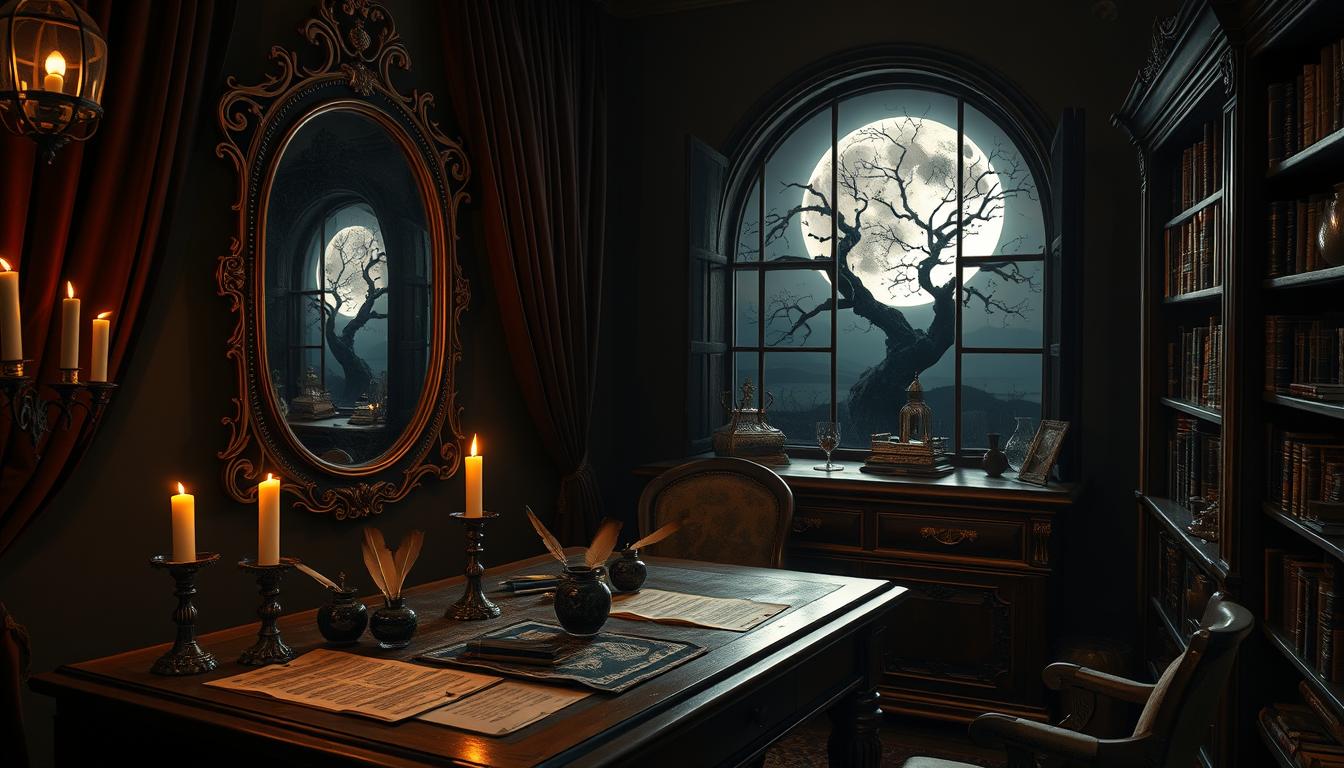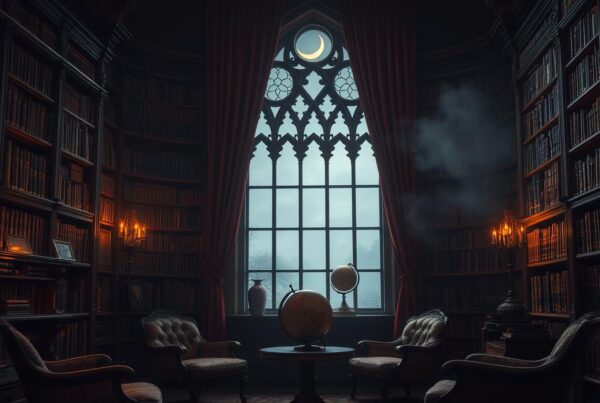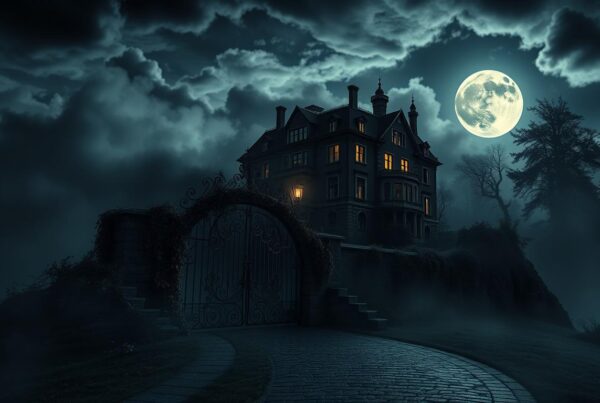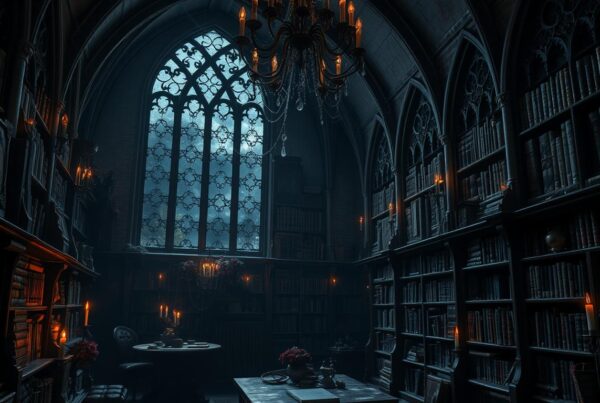Gothic fiction has long captivated readers with its dark romance and suspense. If you’ve ever dreamed of writing your own atmospheric tale, you’re in the right place. This guide will show you how to craft a gothic romance that will keep readers up all night.
We’ll explore the literary techniques that make gothic stories come alive. You’ll learn to create brooding heroes and describe crumbling castles. We’ll also teach you how to weave mystery into your plot and build tension with every page turn.
The art of atmospheric writing is key. We’ll help you create vivid settings that become characters in their own right. Whether you love classic gothic novels or modern dark romance, this article will give you the tools and inspiration to start your gothic writing journey. Get ready to unleash your imagination and create a world where love and fear walk hand in hand.
The Allure of Gothic Romance: Understanding the Genre
Gothic romance draws readers in with its dark mood and passionate stories. It mixes horror, mystery, and romance for unforgettable tales. Let’s dive into what makes gothic romance so captivating.
Key Elements of Gothic Literature
Gothic stories have dark settings, complex characters, and supernatural events. Think crumbling castles, foggy moors, and secret passages. Characters face their inner struggles and danger.
The Evolution of Gothic Romance
Gothic romance started in the 18th century. Horace Walpole’s “The Castle of Otranto” kicked it off in 1764. Later, authors like Ann Radcliffe and Mary Shelley added romance to horror. Today, it keeps evolving, staying true to its roots.
Popular Gothic Romance Tropes
Gothic stories use tropes to add intrigue. You’ll find forbidden love, family curses, and dark secrets. The brooding hero and the strong heroine are common. Ghosts, dreams, and prophecies add suspense.
Crafting Atmospheric Settings: The Heart of Gothic Fiction
Gothic settings are key to scary stories. They come alive, acting like characters. Think of old castles or misty moors.
Creating mood means using your senses. Talk about the cold air, creaking floors, or old book smells. This rich language makes readers feel your story’s mood.
Isolated places are common in gothic stories. Think of lonely manors, forgotten villages, or cliffs. These places make your story feel tense and mysterious.
Weather is also important. Storms, fog, and darkness make scenes feel ominous. Nature shows what’s happening inside your characters.
Settings do more than just set the scene. They shape your story, show character feelings, and build suspense. Mastering these settings will pull readers into your gothic tale.
Developing Complex and Tormented Characters
Character development is key in gothic romance. Gothic protagonists draw readers in with their depth. They face inner struggles, societal pressures, and supernatural forces.
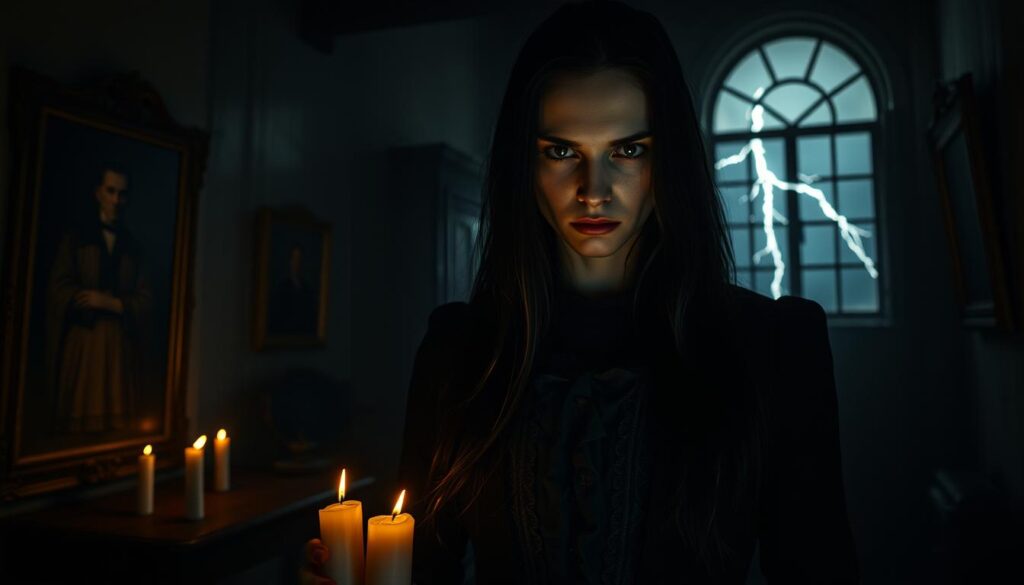
The Brooding Hero Archetype
The brooding hero is a classic in gothic literature. He’s often troubled, mysterious, and has a dark past. He might be a tortured aristocrat or a misunderstood outcast.
Writers can make these characters relatable by showing their hidden sides. They explore the characters’ complex reasons for their actions.
The Vulnerable yet Strong Heroine
Gothic heroines are both strong and vulnerable. They tackle big challenges, often alone or in tough places. Writers show their bravery, smarts, and deep feelings.
A good heroine grows as the story goes on. She faces her fears and breaks free from society’s rules.
Supporting Characters and Their Roles
Supporting characters make gothic stories richer. They can be friends, confidants, or enemies. Writers should think about how they affect the story and show different sides of the main characters.
Good supporting characters add mystery and intrigue. They help make the story more engaging and full of surprises.
Weaving Mystery and Suspense into Your Plot
Gothic romance loves mystery and suspense. A good plot keeps readers excited to find out what happens next. It’s all about pacing and revealing clues carefully.
Start your main mystery early. Add small clues and false leads to keep readers guessing. This makes the story more fun.
Suspense is key to keeping tension high. Use hints of what’s to come to build anticipation. Put your characters in danger to increase the tension.
Cliffhangers at the end of chapters make readers want to keep reading. The secret is to share just enough to keep them curious. But not so much that they figure it out too fast.
Your story’s structure should slowly reveal the plot. Try non-linear storytelling for more suspense. Flashbacks add important background while keeping the story tense.
Switching between different viewpoints helps control what readers learn. With careful planning, suspense, and structure, your gothic romance will grab readers from the start.
The Art of Gothic Dialogue: Creating Tension and Emotion
Gothic romance loves moody talks that make readers shiver. Writing good dialogue is crucial for a real gothic feel. Let’s see how to make talks that take readers to another world.
Balancing Period-Appropriate Language with Readability
Old-timey words make gothic talks special, but they shouldn’t confuse anyone. Use old words like “pray tell” or “I dare say” to bring the past alive. Make most sentences simple but keep a bit formal.
Using Dialogue to Reveal Character and Advance Plot
Gothic characters speak in ways that show who they are. A quiet hero might talk short, while a sneaky villain uses fancy words. Dialogue should show what characters think and feel. It should also help move the story along.
Incorporating Subtext and Hidden Meanings
Subtext makes gothic talks deep. Characters often hide what they really mean. A simple comment might mean something big. Unspoken feelings can make polite talks tense. Learn to say one thing but mean another to keep readers guessing.
Writing gothic dialogue takes time to get right. Read old classics to understand the style. Try different voices and ways of writing. With practice, you’ll write talks that are as spooky as any dark castle or moonlit field.
Exploring Themes of Love, Fear, and the Supernatural
Gothic themes are key in romance novels. They mix love, fear, and the supernatural in a way that grabs readers. It’s all about balancing the mysterious with the real.
Love in these stories is deep and often forbidden. It can cross time and space. Writers show how love can push people to extreme actions, making the story richer.
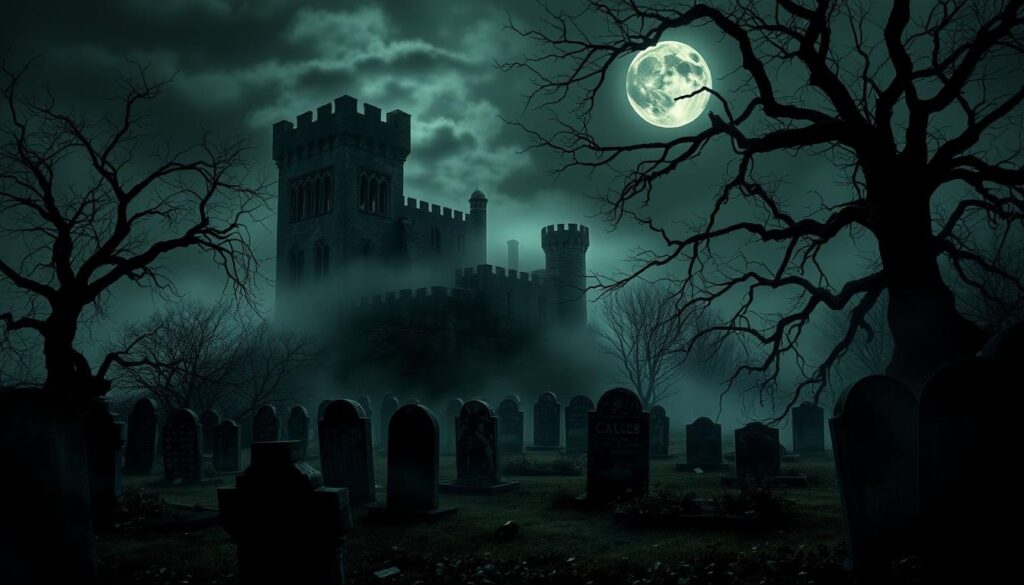
Fear is a big part of gothic stories. It can be a hidden danger or an unseen force. This fear keeps readers eager to find out what happens next.
Adding supernatural elements adds mystery. These can be ghosts or strange events. The goal is to keep readers guessing what’s real.
Writing a gothic romance well is all about balance. Mix love, fear, and the supernatural to create a captivating world. This will pull readers into your story, keeping them hooked until the end.
Finding Your Voice in Gothic Literature
Exploring your author’s voice in gothic literature is thrilling. This genre mixes dark themes with romance, creating a special mood. Your writing style makes you unique in this field.
Uncovering Your Unique Style
Start by trying out different writing styles. Use first-person narration for a personal feel or third-person for a wider view. Experiment with sentence length and speed to build suspense. Your own way of describing places and people will define your gothic voice.
Inspiration from Classic Gothic Works
Reading classic gothic novels can spark your creativity. Edgar Allan Poe’s stories and Emily Bronte’s “Wuthering Heights” are great examples. Notice how they set moods and develop characters. Use these as a base to create your own gothic stories.
Modernizing Gothic for Today’s Readers
Contemporary gothic fiction keeps the genre exciting. Mix old gothic elements with today’s themes. Set your story in a modern city or tackle current fears. This way, you attract new readers while staying true to gothic roots. Your fresh take on gothic themes will make your work shine in today’s market.
Balancing Romance and Horror: The Gothic Sweet Spot
Gothic romance mixes love and fear in a thrilling way. Finding the right balance is crucial for a gripping story. It’s all about mixing romance and horror just right.
Start with a strong romantic plot. Then, add scary moments that test the love. This mix creates tension and moves the story along.
Pacing is key in gothic stories. Switch between sweet moments and scary scenes. This keeps readers guessing and excited.
Use vivid descriptions to set the mood. Imagine a moonlit garden for a kiss or a dark hallway for a ghost. It makes the story feel real.
Characters must grow as they face love and fear. Their journey will make the story more real and engaging.
The aim is to blend romance and horror perfectly. This balance makes gothic romance unique and keeps readers eager for more.
Research Techniques for Authentic Historical Details
To make a gothic romance believable, you need to do deep historical research. We’ll look at how to find good sources and add real details to your story.
Reliable Sources for Period-Specific Information
Begin by visiting trusted libraries and archives. The British Library and New York Public Library have lots of old documents. Online sites like JSTOR have scholarly articles. These help make your gothic story accurate.
Incorporating Historical Events and Figures
Use real historical events and people in your story. The French Revolution or Queen Victoria’s time can make your setting richer. Talking about figures like Edgar Allan Poe or Mary Shelley grounds your tale in history. This makes your gothic romance more real.
Avoiding Anachronisms in Your Gothic Romance
Watch out for anachronisms. Check dates for inventions, social norms, and language. A character in 1800 wouldn’t use a phone or say “okay.” Paying attention to these details keeps your story true to its time, without modern surprises.
